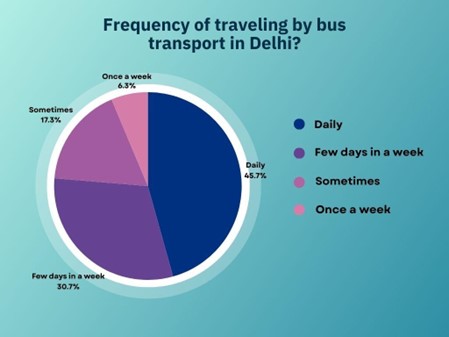Facing administrative neglect over the years, the state of Delhi’s bus queue-shelters, an essential component of efficient public bus transport, needs to be urgently addressed. Bus queue shelters are as important as airports, railway stations and metro stations—providing crucial waiting, boarding, and resting facilities for bus users. It is, therefore, important to create adequate bus shelters with the essential facilities to imagine a just, safe, efficient and inclusive bus transport system. Without the necessary bus shelter facilities, a bus transport system remains unfulfilled and discourages people from using public buses.
The bus queue shelters need to be safe, accessible and inclusive to promote bus use among women and other gendered minorities, differently abled citizens, senior citizens and marginalised communities. While being inclusive is the right thing to do, there is also no other way we could be sustainable as a society.
Further, bus queue shelters can provide relief during extreme weather events such as heatwaves, especially in a city like Delhi which experiences hot summer months. Over the past year, Public Transport Forum Delhi and Greenpeace India have been advocating for a Mobility Heatwave Action Plan for Delhi which recommends the installation of bus shelters across the city. It is pivotal to acknowledge how a people-centric public mobility infrastructure can provide multiple layers of socio-economic benefits such as deepening inclusion, accessibility and urban climate resilience.
According to recent RTI responses, Delhi currently has 4627 bus stops, however, no data is available on public platforms about the number of operational bus queue shelters within the city. At several locations across Delhi, bus queue shelters are either in poor condition with bare facilities or have simply been removed (or missing entirely!). The existing bus queue shelters have many issues: there is no information available about bus schedules, there is a lack of proper safety mechanisms and essential services such as drinking water, facilities for differently abled, public toilets etc.
In 2022, the Delhi government had announced the allocation of INR 75 Crores towards building 1,397 state-of-the-art bus queue shelters. These bus queue shelters have been designed to provide essential amenities such as real-time tracking and bus schedules along with safety measures such as panic buttons, LED lights and CCTVs. However, no data has been provided on whether these shelters have been made operational.
There are various locations in Delhi where bus queue shelters remain missing. One such place is the bus stop (205 bus stand) at Sunder Nagri near Dilshad Garden, where the existing bus shelter was dismantled by the authorities and hasn’t been replaced with another structure. The lack of a bus shelter at Sunder Nagri has been a source of inconvenience for local bus users including women, children and differently abled citizens. Daily bus users in Sunder Nagri use public buses for commuting to their workplaces, schools, colleges, for care work etc., and the missing bus queue shelter has been a major hindrance to accessing public mobility.
Opinion poll of Sunder Nagri’s bus users
In order to gather the citizen’s responses about the missing bus queue shelter, we conducted an opinion poll of 300 bus users at Sunder Nagri. The survey focuses on the missing shelter while also capturing citizen’s support towards the demand for setting up an adequate bus queue shelter for the community. The survey also records the occupation of the bus users and the frequency of public bus travel.
Frequency: 45.7 percent of the respondents use public buses daily, 30.7 percent use buses few days in a week, 6.3 percent once a week and 17.3 percent respondents use public buses sometimes. Significant number of those surveyed at Sunder Nagri are frequent public bus travellers, further bolstering the need for a dedicated bus shelter and improvement in the overall bus infrastructure of Delhi.

Demand for a bus queue shelter at Sunder Nagri: The main focus of the opinion survey was to examine the extent of community support for setting up a bus shelter. Each of the 300 surveyed respondents supported the demand for setting up a bus shelter at the designated bus stand in Sunder Nagri.

The opinion poll results point towards the citizen’s demand for an adequate bus queue shelter at Sunder Nagri. Although this survey includes 300 participants and is restricted to Sunder Nagri, the demand for bus queue shelters has been voiced by several communities in areas where bus shelters are either completely missing or the existing shelters are in poor shape.
Recommendations
There is an urgent need for setting up bus queue shelters at every bus stop in Delhi. These shelters should have adequate facilities for all bus users including women and other gendered minorities, differently abled citizens, senior citizens and children. The following recommendations for bus transport infrastructure should be incorporated into the upcoming state budget of Delhi for 2023-2024:
- Bus queue shelter at every bus stop in Delhi: At every bus stop in Delhi, there must be a bus queue shelter with all essential and safety facilities for bus users.
- Safety: All bus queue shelters need to have functional safety measures, especially for women and other gendered and sexual minorities. Bus shelters should have panic buttons, sufficient street lighting, emergency helpline numbers, and a quick redressal system for women and other bus users to report instances of harassment.
- Differently abled-friendly bus shelters: Bus queue shelters in Delhi should be accessible to differently abled citizens. The official accessibility guidelines by the Ministry of Road Transport and Highways for bus terminals and bus stops are already available in the public domain. The Delhi government should ensure that bus queue shelters in Delhi adhere to these guidelines.
- Non-motorised transport infrastructure: Along with bus stops, non-motorised transport (NMT) options such as walking and cycling play a vital role in ensuring first and last mile connectivity. In Delhi, a large section of the population uses NMT for first and last mile connectivity and it will be useful for them to have infrastructure such as cycle stands available at bus queue shelters.
- Essential services: Bus queue shelters should have essential facilities such as drinking water, comfortable seating, overhead shelter, information about bus schedules, and public toilets.
- Care giving facilities: The Delhi government should ensure that bus queue shelters and buses must have caregiving facilities to accommodate women passengers with children.
- Car Parking: At various locations in Delhi, bus lanes and areas surrounding bus shelters are often used as parking spots for private cars. This phenomenon can be witnessed at multiple places and no strict action has been taken against these private car owners. The Delhi government should designate bus lanes and areas surrounding bus shelters as no parking zones with heavy fines including seizure of vehicles.
- Digitization: Bus queue shelters should have a real-time bus tracking system with a public announcement system that can provide information about the estimated arrival time of buses. Every bus queue shelter in Delhi should have a digitised route map which is user-friendly and provides information in a simplified form.
- Dedicated fund for bus transport infrastructure: A dedicated fund for bus transport infrastructure should be introduced by the Delhi government in the upcoming state budget of 2023-2024. This fund should be used for developing and upgrading bus transport infrastructure in the city which includes building new bus queue shelters and upgrading the old ones, introducing sound safety measures, and creating a public mobility infrastructure that furthers the socio-economic inclusion of historically marginalised sections of the population.
Acknowledgements
Opinion Survey Team: Deepali, Zeba, Anjali Sinjali, Amit Gautam, Hema, Rocky and Nisha.
Author: Aakiz Farooq
